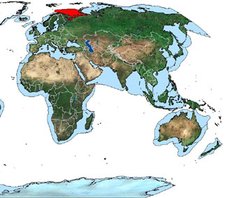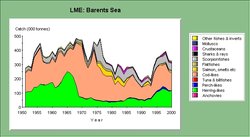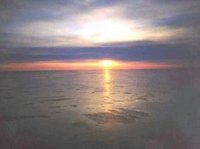Barents Sea large marine ecosystem
 Location of the Barents Sea Large Marine Ecosystem. (Source: NOAA)
Location of the Barents Sea Large Marine Ecosystem. (Source: NOAA) The Barents Sea Large Marine Ecosystem (LME)is a high-latitude ecosystem; an extreme environment because of the high latitude, large seasonal and annual changes in ocean climate, and its position near the Arctic Ocean. It is situated between 70° and 80° N on the North European continental shelf, and is a relatively shallow sea with an average depth of 230 meters (m). Its topographical features include the Spitsbergen, to the North, and Novayazemlya to the east. The LME is bounded by Atlantic water in the south and west, and by Arctic or mixed water in the north and east. The Atlantic water is characterized by salinities around 35.0 parts per thousand (ppt) and temperatures of 2° C or higher. The Arctic water is typically colder than 0° C and has salinities from 34.3 to 34.8 ppt. The exchange of bottom water causes periodic variations that help explain the observed variations in ocean climate and ice cover. This ice-cover extends over 1/3 to 2/3 of the Barents Sea and varies considerably during the year and inter-annually. The LME is driven by climatic conditions, e.g. temperature, which has a great influence on the distribution, growth and recruitment of the LME’s major fish species.
Contents
Productivity
 LME Barents Sea. (Source: NOAA)
LME Barents Sea. (Source: NOAA) The Barents Sea LME is considered a Class II, moderately high productivity (150-300 grams of Carbon per square meter per year), ecosystem based on SeaWiFS global primary productivity estimates.There are three major current systems, the Norwegian coastal current, the Atlantic current and the Arctic current systems, and bottom topography strongly influences the circulation and distribution of water masses. The LME is characterized by highly variable conditions. Its climatic variations depend mainly on the activity and temperature of the inflowing Atlantic water. These climatic conditions, and the extent of the ice cover, have a pronounced effect on bioproductivity and fish stock recruitment. There are significant interannual variations in spring phytoplankton bloom dynamics, zooplankton stocks and fish recruitment. Predation pressure and climatic fluctuations are possible causes for these variations. The high latitude ecosystem is characterized by a food web with few dominant species (diatom, krill, capelin, cod). However, interactions between fish and zooplankton as well as among fish stocks have led to marked changes in the trophic pathways and in fish and zooplankton abundance. The capelin biomass has severely declined (see Dalpadado et al., 2001). Predation by young herring on capelin larvae is regarded as the main cause of the recruitment failure of capelin in the Barents Sea. Thus, periods of high abundance of young herring (1983, and 1991-1992) were followed by low capelin abundance. As capelin are the key species of the LME, the collapse of the stock caused food shortages for higher trophic level populations such as cod, harp seals, and guillemots. Cod, which preys heavily on capelin, had to switch to macrozooplankton such as krill and amphipods as its main prey when the capelin levels were low.
Fish and Fisheries
 (S. Frolov, Source: NOAA)
(S. Frolov, Source: NOAA) The Barents Sea LME is an important feeding area for cod, capelin, haddock, herring, sea perch, catfish, plaice, halibut, Atlantic salmon and redfish, and it supports a large fishery. Total catches and their composition have varied significantly in the last few decades. There was a catch decrease for almost all the commercial fish species. Annual cod catches are around 250,000 tons. The herring stock was very low in the 1970s due to overfishing in the 1960s. 1983 saw a strong year class, as did the warm years of 1989-1991. The Barents Sea capelin stock is potentially the largest capelin stock in the world, with its biomass in some years reaching 4 to 8 million metric tons. It was the largest Norwegian fishery in terms of total catch. Capelin is a plankton feeder and migrates on a large scale to exploit the plankton productivity of the northern Barents Sea, trailing the retreating ice with a time delay (see Sakshaug and Skjoldal, 1989). However, the fish resource has shown major changes in the past two decades. In the late 1970s, the annual fish catch was around 2.5 million metric tons. In 1986, it collapsed to a stock size of less than 100,000 metric tons. At present, the annual catch is around 1 million metric tons (ICES, 2000). The significant decline led to a complete closure of the capelin fishery from 1994 to 1998. More recently the capelin stock has started to increase again. Because the capelin occupies a key role as an intermediate link in the food web, this stock affected other components of the Barents Sea ecosystem, leading to the poor growth of cod (see Monstad and Gjoesaeter, 1987), massive seal invasions along the Norwegian coast, and high seabird mortality (see Skjoldal, 1990). Preceding the capelin decrease, strong year classes of cod, haddock, and herring were produced in 1983. There was also an observed transition between cold and warm climatic periods, suggesting that good recruitment is related to increased or altered inflow activity into the Barents Sea. Detailed studies of the diet of capelin and cod, as well as of other major predators such as mammals and birds, should be investigated in a multispecies context. In August 2001, the 9th Russian-Norwegian Symposium was held in Russia on technical regulations and by catch criteria in Barents Sea fisheries. A joint Norwegian/Russian acoustic survey in the Barents Sea estimated sizes of capelin and polar cod, their biology and their geographical distribution. More information on the ecological changes in the Barents Sea can be found at Norway's Institute of Marine Resources. The University of British Columbia Fisheries Center have detailed fish catch statistics for this LME.
Pollution and Ecosystem Health
Nutrient concentrations (nitrates, phosphates, and silicic acid) are significantly lower than in other polar areas (see Sakshaug and Holm-Hansen, 1984). Industrial activities linked to transportation, oil and gas extraction and runoff are the main pollution sources. The oil and gas industry is potentially dangerous to the marine ecosystem. There has been atmospheric fallout from nuclear tests and from the Chernobyl accident. Another issue is the salvage operation of the Russian nuclear submarine “Kursk” in the Eastern Barents Sea. There was concern for possible radioactive contamination. BASIS, the Barrents Sea Impact Study is a global change research project developed under the auspices of the International Arctic Science Committee (IASC).
Socioeconomic conditions
 (Source: NOAA)
(Source: NOAA) The economy and population are connected to the LME either directly or indirectly, though 3 main marine activities: fisheries, oil and gas extraction, and sea transportation. Until the end of the 19th century, Russian fishing was limited to the [[coastal] zone]. Industrial fishing developed in the second half of the 20th century. Today Norway and Russia, both operating in the Barents Sea Large Marine Ecosystem, have a modern fishing industry. The two countries share stocks of cod, capelin and haddock. Close cooperation is needed in the management of these transboundary fisheries resources. Kamchatka crab was successfully introduced in the coastal waters of the Kola Peninsula. The Norwegian Government is to develop a giant gas field, the Snoehvit field, in the Barents Sea in 2002.
Governance
The Barents Sea LME is bordered by Norway and Russia. There are issues pertaining to the former Cold War boundary between the Soviet Union and the countries of Western Europe. The changing and transboundary nature of the marine fisheries of this LME requires management approaches that recognize an ecosystem perspective in fisheries research and management. For cooperation between the fisheries ministries of the two countries, see Norway's Ministry of Fisheries page. Institutes and universities in Norway participated in the Pro Mare Program (1984-1989). Symposia dealing with issues pertaining to both Russia and Norway continue to be held on a regular basis.
References
- Anonymous. 1987. Ressursoversikt for 1987. Fisken Hav. 1987. (Saernummer 1):1-84.
- Anonymous. 1992. Ressursoversikt for 1992, Havforskningsinstituttet. Fisken Hav. S. No.1.
- Blindheim, Johan and Hein Rune Skjoldal, "Effects of Climatic Changes on the Biomass Yield of the Barents Sea, Norwegian Sea, and West Greenland Large Marine Ecosystems," in Kenneth Sherman, et al., Large Marine Ecosystems: Stress, Mitigation, and Sustainability (Washington, D.C.: American Association for the Advancement of Science, 1993) pp. 185-198. ISBN: 087168506X.
- Dalpadado, P., Bogstad, B., Gjosoeter, H., Mehl, S. and H.R. Skjoldal, 2001. “Zooplankton-fish interctions in the Barents Sea.” In K. Sherman and H.R. Skjoldal, eds. Large Marine Ecosystems of the North Atlantic—Changing states and Sustainability. Volume in press, Elseviers. 269-291. ISBN: 0444510117.
- Dragesund, O., and Gjoesaeter, J. 1988. The Barents Sea. In The ecosystems of the world. Vol. 27. Continental Shelves. Pp. 339-361. Ed. By H. Postma and J.J. Zijlstra. Elsevier.
- Dragesund, O., Hamre, J., and Ulltang, Oe. 1980. Biology and population dynamics of the Norwegian spring spawning herring. Rapp. P.-v. Reun. Cons. Int. Explor. Mer. 177:43-71.
- Hamre, J. 1985. Assessment and management of Barents Sea capelin. In The proceedings of the Soviet-Norwegian symposium on the Barents Sea capelin, Bergen, 14-17 August 1984. Pp. 5-24. Ed. By H. Gjoesaeter. Institute of Marine Research, Bergen, Norway.
- Hassel, A., Loeng, H., and Skjoldal, H.R. 1986. Marin oekologiske undersoekelser I januar 1985. Havforskningsinstitutte Rapport nr. FO 8604:1-33, Bergen. (English abstract).
- ICES, 2000. Report of the Arctic Fisheries Working Group. ICES CM 2000/ACM:3. 312 p.
- Loeng, H. In press. Ecological features of the Barents Sea. In Proceedings of the sixth international conference of Comite Arctique: Marine living systems of the far north. Fairbanks, Alaska, May 1985. 54 pp.
- Loeng, H., et al. 1992. Climatic variability in the Norwegian and Barents Sea. ICES Mar. Sci. Symp. 195
- Midttun, L. 1985. Formation of dense bottom water in the Barents Sea. Deep Sea. Res. 32:1233-1241.
- Midttun, L., and Loeng, H. 1987. Climatic variations in the Barents Sea. In The effect of oceanographic conditions on distribution and population dynamics of commercial fish stocks in the Barents Sea. Proceedings of the third Soviet-Norwegian symposium, Murmansk, 26-28 May 1986. Ppp. 13-27. Ed. By H. Loeng. Institute of Marine Research. Bergen, Norway.
- Monstad T., and Gjoesaeter, H. 1987. Observations on polar cod (Boreogadus saida) in the Barents Sea 1973-1986. ICES C.M. 1987/G:13.
- Rey, F., and Skjoldal, H.R., and Slagstad, D. 1987. Primary production in relation to climatic changes in the Barents Sea. In The effect of oceanographic conditions on distribution and population dynamics of commercial fish stocks in the Barents Sea. Proceedings of the third Soviet-Norwegian symposium, Murmansk, 26-28 May 1986. Ppp. 29-46. Ed. By H. Loeng. Institute of Marine Research. Bergen, Norway.
- Roettingen, I. 1985. Norwegian investigations in 1984-1985 on juvenile herring. ICES C.M. 1985/H:53.
- Sakshaug, E., and Holm-Hansen, O. 1984. Factors governing pelagic production in polar oceans. In Marine phytoplankton and productivity. Pp. 1-18. Ed. By O. Holm-Hansen, L. Bolis and R. Gilles. Springer Verlag, Berlin. ISBN: 038713333X.
- Sakshaug E., C.C.E. Hopkins, and N.A. Oritsland, 1991. Proceedings of the Pro Mare Symposium on Polar Marine Ecology, Trondheim, Norway. Polar Research 10:1-662.
- Sakshaug, E. and Skjoldal, H.R. 1989. Life at the Ice Edge. Ambio 18:60-67.
- Skjoldal, H.R. 1990. Management of marine living resources in a changing ocean climate. In: Papers presented on the session "Research on natural resources management" of the Conference "Sustainable development, science and policy," Bergen 8-12 May 1990. Bergen Foundation of Science Rep. No. BFS A90005, pp.1-7. Bergen, Norway.
- Skjoldal, Hein Rune and Francisco Rey. 1989. "Pelagic Production and Variability of the Barents Sea Ecosystem" in Kenneth Sherman and Lewis M. Alexander (eds.), Biomass Yields and Geography of Large Marine Ecosystems (Boulder: Westview, AAAS Selected Symposium 111, 1986) pp. 241-286. ISBN: 0813378443.
| Disclaimer: This article contains certain information that was originally published by the U.S.National Oceanic and Atmospheric Administration (NOAA). Topic editors and authors for the Encyclopedia of Earth have edited its content and added new information. The use of information from the NOAA should not be construed as support for or endorsement by that organization for any new information added by EoE personnel, or for any editing of the original content. |